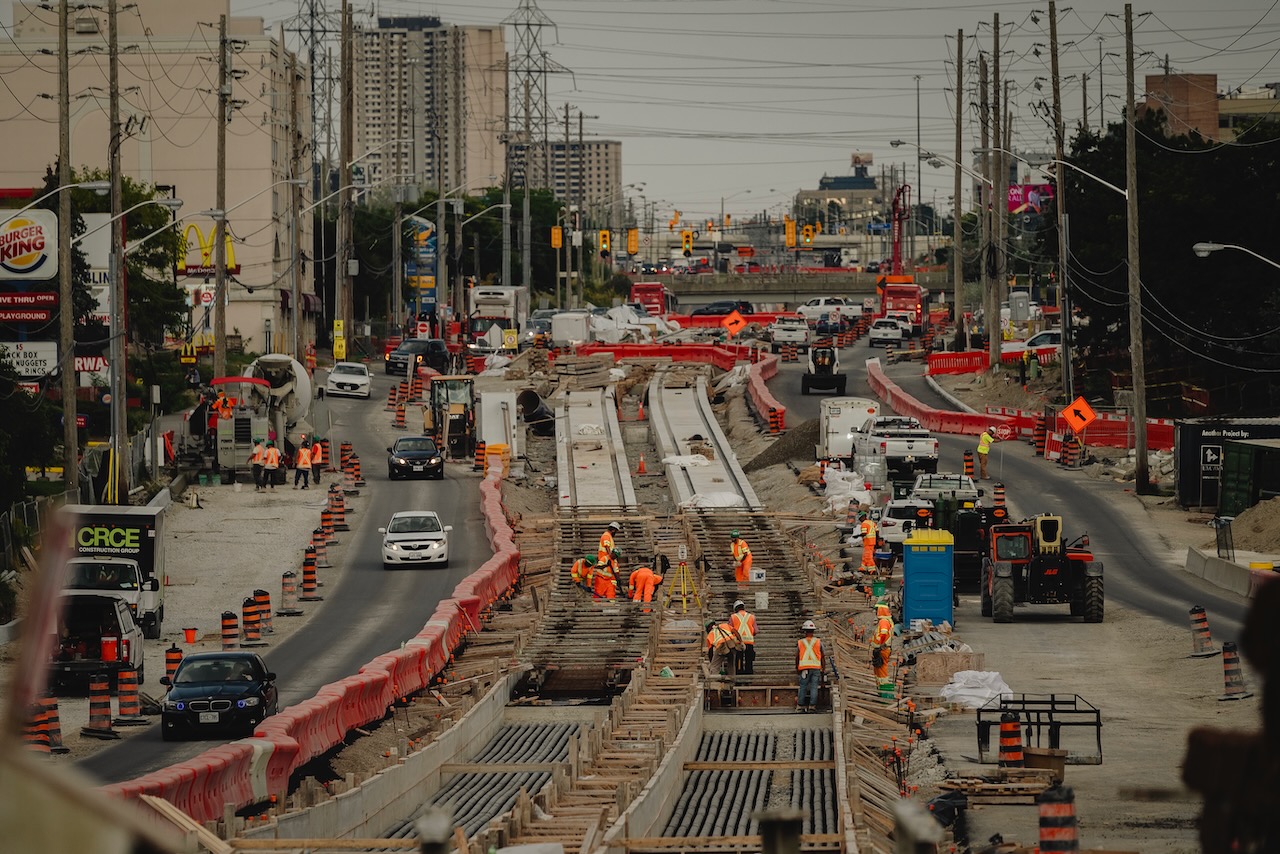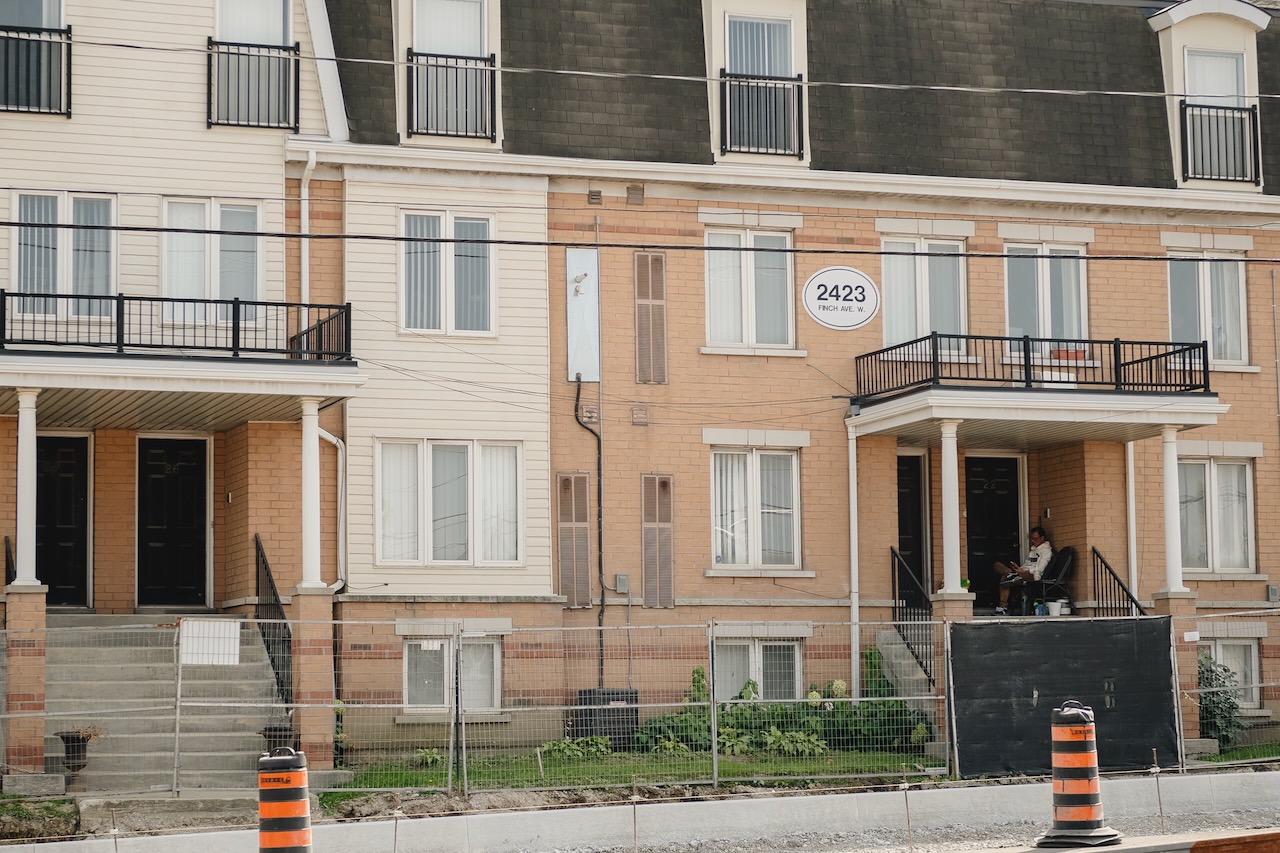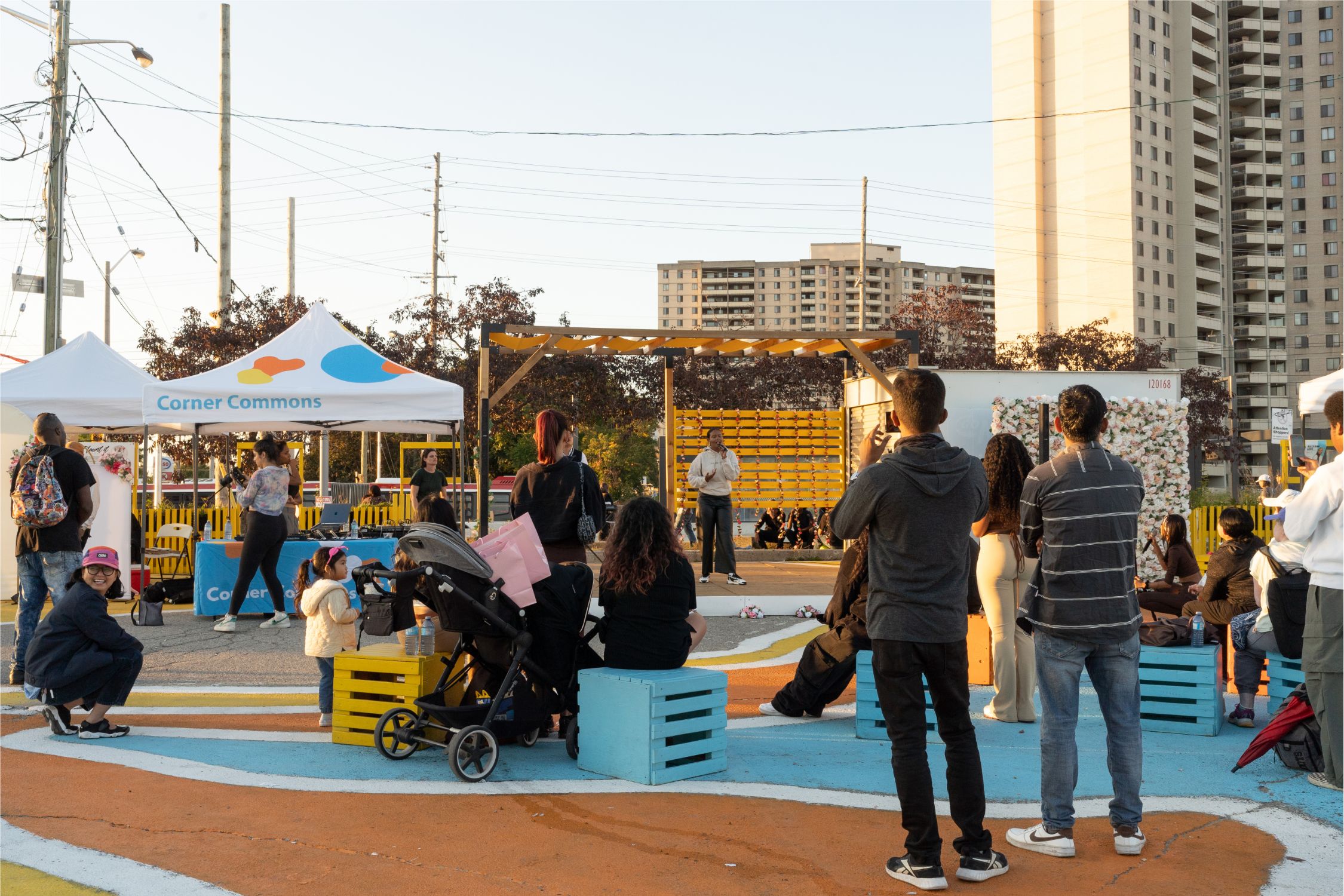Getting off the subway at Finch West station is like entering an celestial vision of Toronto’s promised future. With its gleams of natural light through neat rectangular panes of yellow and purple glass, the station beckons towards the interconnected city local politicians have been touting, on and off, for years.
Travelling east along the path that will eventually connect the station to the other side of the TTC loop, however, is a whole different story.
Right outside the subway is a construction zone, a circuitous path from Keele Street along Finch that leads to a hard-to-find temporary bus stop. Riding that 36b Finch bus on a gloomy Thursday in August, about 10 TTC commuters find themselves dumped unceremoniously a few metres east of the Jane intersection. “Be careful now,” cautions the driver to one passenger, as she exits gingerly alongside a car whizzing by, uncomfortably close.
Already one of the most vulnerable neighbourhoods in the city—predominantly racialized, working class, and stigmatized by local media—Jane and Finch is currently a mess of uneven pavement, disrupted traffic and confusing or ambiguous signage. Crossing the intersection sometimes means climbing or squeezing between ubiquitous orange plastic barriers emblazoned with the name “Mosaic Transit Group” and sometimes “temporary pedestrian walkway.” It’s a never-ending cacophony of car horns.

There’s an unmistakable irony. With its 18-stop, 11-kilometre line, the Finch West Light Rail Transit (LRT) project will eventually increase ease of access for a vibrant community of Torontonians who are often some of the city’s most neglected. In the meantime, though, drivers and pedestrians along Finch—not just at Jane, but west through Rexdale all the way to Humber College—have to endure years of disruptions and interruptions to the built environments they navigate every day.
It’s not just the Finch West LRT: versions of this scene are unfolding across different pockets of the city.
Toronto is in the midst of a long-delayed transit construction boom. After decades of stagnation, various levels of government have finally aligned and put their money where their mouth is, building a series of transit projects that will connect the city in unprecedented fashion. From the infinitely delayed Eglinton Crosstown to the Yonge Extension pushing into the York Region, the Hurontario line cutting through Peel, and the Scarborough subway, it’s a genuinely historic moment.
Metrolinx has emphasized the future and undeniable benefits that transit expansion will afford the city—but the goalposts are constantly moving, with opening dates pushed and pushed again, and no part of the transit authority’s approach seems to account for the strain this causes communities.
Building a large infrastructure project like an LRT line is always a balancing act between the needs of future residents and the people who live there now, the good it will provide to the whole city and the safety and wellbeing of the individuals who live directly in its path. But on Finch West, it feels especially out of balance. The neighbourhood is a mess, and many are openly worrying if any of the decision-makers even care.





“It feels like it’s Canada’s worst obstacle course,” says Elise Antoniadis, community planning coordinator at the Jane/Finch Centre, a local non-profit. “People are having to take all these safety risks just to continue their daily lives.”
All it takes is a few minutes standing at the intersection to see the effects, and from June to October last year Antoniadis did just that. It was part of the equity-driven community engagement process included in the official Jane Street Road Safety Review, a collaboration between architecture firm IBI Group, the city of Toronto, and the TTC’s RapidTO initiative to improve bus and streetcar access in priority neighbourhoods.
In addition to walking tours and virtual meetings, they stood at Jane and Finch and other high-traffic spots along Jane and asked people what they thought of the construction. They engaged over 200 residents in conversation, and heard firsthand accounts that ranged from people tripping on holes in the sidewalk, to unavoidably having to jaywalk to reach the Yorkgate and Jane-Finch malls, where many seniors and other residents go grocery shopping or grab coffee from Tim Hortons.
“People would get pretty riled up at the bus stop,” says Antoniadis. “That major intersection is basically gutted. The stop lights aren’t even on most of the time, and you have these huge construction vehicles crossing these intersections where people are trying to walk. They try to fix this by putting pedestrian barriers, but they’re made of plastic. That’s not going to stop this huge truck if it turns and it can’t see you.”

When asked about safety considerations during construction, a spokesperson for Metrolinx, the provincial transit authority developing the LRT (along with the Eglinton West LRT and Ontario Line) said they “maintain open communication with community stakeholders to ensure concerns about pedestrian access are addressed proactively.” They give a few examples, such as a temporary pedestrian walkway overtop construction at Kipling Avenue and Albion Road.
They point more to “planned improvements,” including dedicated bike lanes separated by mountable curbs, new traffic lights and sidewalks, and a new multi-use tunnel under the Highway 400 southbound onramp to provide a safe traffic bypass for cyclists and pedestrians. “When this work is complete, pedestrians can safely cross at every intersection.”
However, some in the affected communities feel like they’re sacrificing access and safety in the short-term. The prevailing sentiment among many in Jane and Finch, says Antoniadis, was that the community was not being properly listened to or considered by people making decisions about their neighbourhood.
There’s a history of community consultation without proper follow through, they say, which has left many people questioning if the decision makers in the city are looking out for the safety of the largely racialized and working class area.

Antoniadis, who lives at Eglinton and Keele, notices a marked disparity between Finch West and Eglinton LRT construction. “There’s definitely a class issue there,” they say. “At [the major midtown intersection] Yonge and Eglinton, for example, with the LRT, they have community safety officers, they have barriers, crossing guards, a lot of stuff to make people feel safe. But I don’t see those same precautions being taken at Jane and Finch.”
Downtown, where Ontario Line construction will shut down busy portions of Queen Street for at least five years, there’s also a marked difference. At Queen and University and north towards Armoury Street, dedicated police officers direct traffic where intersections have been fenced off.
Walking eastward on Queen often means veering left and right as gates and barriers force pedestrians to cross and recross the street, or sometimes walk directly into the road. The signage is much clearer and easier to follow than on Finch West, which means it rarely feels as dangerous, but it’s undeniably disruptive. The historic Osgoode Hall grounds are cordoned off, the green respite in the middle of the city a mess of plastic barricades. Toronto’s busiest mall, the Eaton Centre, is considerably less accessible, with signs affixed to orange fencing instructing people with disabilities on how to find barrier-free access to it and its neighbour, The Bay. West of Spadina, many long-running businesses, restaurants, even a doctor’s office have been expropriated to build the new subway extension.
Along Eglinton, where the Crosstown LRT construction has been ongoing for more than a decade, local city councillors Josh Matlow and Mike Colle estimated in 2020 that at least 140 businesses had closed since construction began. That year, the Ontario government pledged an additional $3 million to fund marketing and promotion of businesses impacted by the LRT construction, part of which was earmarked to directly fund the City of Toronto’s Black Business and Professionals Council Advisory Body. But for many businesses, it was too little too late. Little Jamaica, one of the neighbourhoods with the most Black-owned businesses in the city, was hit especially hard. While there will be an obvious benefit to the area when the work is complete—though there’s still no sign of when that will be—many have been displaced long before they could ever see it.
That’s a prevailing worry at Jane and Finch, where construction also carries a risk of gentrification. With greater transit access comes residential and commercial development, which can threaten to displace people who’ve lived in the area for years, even generations. So, when the dust settles, the area could look very different.

Meanwhile, the streets don’t improve much as you travel eastward along Finch. On Weston, as the rain starts to fall, a short-turning bus deposits TTC riders to another makeshift temporary stop without shelter. Seeking refuge, one university-aged woman climbs over a plastic barrier to duck for cover under a tree. Unpaved streets turn to mud.
At Kipling, the future Mount Olive LRT stop already looks sleek and modern, yet it’s inaccessible to current commuters. Instead, disoriented looking seniors with walkers and electric scooters navigate jagged sidewalks that end abruptly.
According to 2016 census data, 30 percent of Rexdale-Kipling’s population is over 55 years old, and this is the demographic that often bears the brunt of transit construction and disruption.
“Except maybe in rush hours, they are the users of those systems [of transit],” says Bill VanGorder of the Canadian Association of Retired Persons. “It’s a good example of how, although they claim otherwise, when the decision-makers think about how they’re going to mould the city, they don’t often think about the older, less mobile members of the community.”

It’s an easily visible problem along construction routes, VanGorder says. Public transportation is key for older people, many of whom don’t have the option of driving in the city. Many are also on fixed incomes, and don’t have the money to spend on taxis or Ubers when they feel unsafe along the roads.
According to Metrolinx and the city, the LRT will eventually improve road safety along Finch, but the message doesn’t land for many seniors, says VanGorder. “If you say to an 80-something-year-old ‘it will be ready in five years,’ it’s in one ear and out the other,” he says. “For an 80-something, or somebody with mobility issues, they need something now. Waiting a few years is not something they want to hear.”
There’s no question that better public transportation will make a big difference, not only on Finch but throughout all of Toronto. In the meantime, though, it’s going to be a bumpy ride.
The Finch West Issue is made possible through the generous support of United Way Greater Toronto and Metcalf Foundation. All stories were produced independently by The Local.










